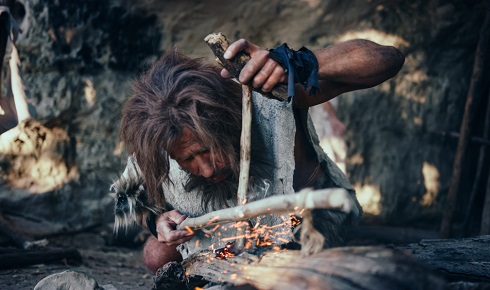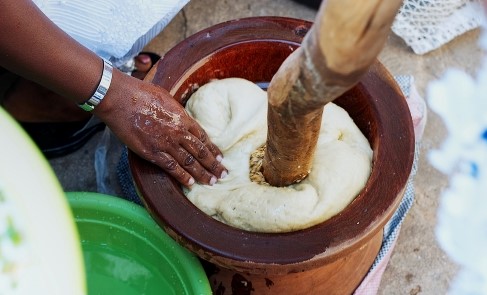What was on the prehistoric menu?

Cutting edge bioscience is helping generate a new appreciation of hunter-gatherer cuisine - and evidence of culinary sophistication that pre-dates the first farmers
12th December 2022
Picture a prehistoric meal and what comes to mind? A fireside meat feast, perhaps served with a side of foraged nuts and fruit? Archaeologically speaking this scene, reminiscent of so many Hollywood films and museum dioramas, carries some weight. Butchered bones, discarded fruit stones and cracked nut shells are found in large quantities at hunter-gatherer settlements around the world.
However, the adoption of techniques from the biological sciences are showing us another side of palaeolithic cuisine. From food scrap botany to organic residue analysis picking out lipid biomarkers inside millennia-old pots, the latest ‘bioarchaeology’ is revealing a prehistoric menu more varied and sophisticated than anyone expected.
 Chemical analysis and other techniques such as microbotany are helping scientists reveal what early humans ate in unprecedented detail.
Chemical analysis and other techniques such as microbotany are helping scientists reveal what early humans ate in unprecedented detail. The groundwork for this emerging field was laid in the 1990s when figures such as Richard Evershed at Bristol University honed the techniques to isolate organic materials from pots and identify their components. Today, next-generation sequencing methods such as chromatographic and mass spectrometric analyses are enabling a community of archaeologists to take all potential biomarkers extracted from a site or artefact and sequence them. The results can then be used to taxonomically assign the ingredients of millennia-old recipes.
Another emerging technique focuses on the organic matter found in prehistoric hearths and firepits. Historically dark clumps of organics have often been discarded or mistakenly labelled as charcoal. However, the application of scanning electronic microscopy, familiar to microbotanists and plant anatomists, has revealed they can contain plant tissue microstructures. These are not only a signature of ancient leftovers, but when compared with botanical reference material of plant parts, can be matched to specific ingredient species, as well as the cooking techniques employed in their preparation.
Together these bioarchaeology techniques are enabling us to take a new tasting tour of hunter-gatherer cuisines and bring new food groups to the prehistoric meal table.
Carb-reloading ancient diets
While trendy palaeodiets often warn against carbohydrate-heavy legumes, cereal grains and potatoes, the historical authenticity of this idea is looking more and more dubious.
An early example comes from a 30,000-year-old artefact excavated from caves in southern Italy. Marta Mariotti from the University of Florence carried out residue analyses on a pestle-like grinding tool, which showed that partially swollen and gelatinised wild oats (Avena caryopsis) were heated or toasted before processing. Mariotti believes water could have been added back in to make a porridge-like consistency, although her paper also proposes an ancient relative of the region’s popular acorn bread.
Although the final dish enjoyed by this Italian cave community remains unknown, bread’s prehistoric roots were later confirmed at a 14,000-year-old settlement in Jordan’s Black desert. There, University of York’s Lara González Carretero analysed the clumps of burnt material within a firepit and revealed the pericarp tissue and endosperm cell structures of a local wild wheat (Triticum boeoticum), processed into a type of flatbread.
 Modern-day fufu being pounded in Ghana. The starchy dough-like food may have originated in the Nok era, one of the earliest African ironworking and terracotta cultures.
Modern-day fufu being pounded in Ghana. The starchy dough-like food may have originated in the Nok era, one of the earliest African ironworking and terracotta cultures. In the years since, Carretero and a new community of archaeobotanists have run laboratory analyses on the structural impact of culinary preparations such as grinding, milling, roasting and boiling on various cereals available to hunter-gatherers across Eurasia. Today, measuring the size of air bubbles and coarseness of the underlying organic matrix can distinguish clumps of flatbreads from doughier or more tortilla-like breads, or even identify porridge or gruel-like mushes from ancient soups.
At the site of a 9,000-year-old village called Çatalhöyük in Turkey, Carretero’s analysis of charred food samples found signs of soups made with pulses and cereals, as well as ground legume flatbreads. There were also frequent traces of an oilseed species (Descurainia sophia), described by Carretero’s colleagues as a possible early condiment. Outside of cereals, another source of hunter-gatherer carbs was likely root vegetables. In Jordan, Carretero’s teams showed a number of crumbs from the ‘world’s oldest bread’ contained tissues linked to club-rush tubers (Bolboschoenus maritimus).
On the other side of Europe, on the island of Harris within Scotland’s Outer Hebrides, Rosie Bishop from the Arkeologisk museum in Norway used scanning electron microscopes to reveal the preparation of two root tubers – heath pea (Lathyrus linifolius) and pilewort (Ficaria verna) at a hunter-gatherer site occupied during 8th–7th millennium. This discovery came after Bishop’s laboratory work showed the carbohydrate and energy content of a range of native British root vegetables can be higher than modern cultivated potatoes.
Getting your greens
With carbs back on the pre-agricultural table, another component of our modern diet lacking from the prehistorical records are leafy greens. While there is no reason to assume hunter-gatherer communities weren’t taking advantage of the wild brassicas or cruciferous vegetables in their local environment, it has been difficult to prove our ancestors’ veggie credentials.
 Evidence from Libya suggests aquatic plants, such as pondweed, may have been boiled before being eaten.
Evidence from Libya suggests aquatic plants, such as pondweed, may have been boiled before being eaten. With remnants of leafy greens unlikely to survive archaeological time at any macro scale, hopes rested with organic residue biochemical analysis inside cooking pots. However, direct evidence for plant processing in prehistoric ceramics has not been forthcoming within Europe, where any plant lipid biosignatures appear to be drowned out by the fat-filled meat constituent of their meals. Outside of the continent, however, there have been some notable successes.
Julie Dunne’s track record in finding plant processing signatures within the hunter-gatherer pottery of North and West Africa could imply a greater reliance on plants in these communities’ diets. However, the biomolecular archaeologist at the University of Bristol suggests an alternative theory – a tendency to use specialist pots for cooking greens. One of Dunne’s projects in the Libyan Sahara, which hunter-gatherers inhabited between 8200 and 6400 BC, revealed evidence for the boiling of aquatic plants such as the pondweed Potamogeton.
Another analysed the lipids deposited on pots from the Nok culture, one of the earliest known societies of western Africa, found in present-day Nigeria. As well as searching for ancient biomarkers, Dunne’s approach often draws on modern culinary cultures to help fill in gaps in the archaeological record. In West Africa she has proposed a Nok-era origin for one of the region’s most popular modern dishes. Fufu is made from yam and served with a broth or sauce made from local vegetables. Dunne’s suggestion that this dish could link back to antiquity comes from her Nok pot samples, which contain evidence of starchy tubers such as yam, alongside leafy species like jute mallow (Corchorus olitorius), African eggplant (Solanum aethiopicum), and okra (Abelmoschus esculentus), all widely used in regional cooking today.
Hunter-gatherer cuisine reviewed
There has long been an assumption that only through farming did humans create the settled societies that enabled them to move beyond more ancient ways of life. Culinary traditions have long been wrapped up in this narrative.
 New data on early food culture could change our understanding of the very earliest human communities and why agriculture developed.
New data on early food culture could change our understanding of the very earliest human communities and why agriculture developed. “We all have this idealised view of hunter-gatherers where the men pop out and go off on a hunt and bring back some meat,” says Dunne. But that familiar picture omits both the gathering role of women and the diversity of food we now know these people were eating. “Quite often the men came back unsuccessful. But the women were always going to be successful, so there was always something to cook. And if it was starchy plants, which fill you up, they were going to be happy enough with that,” she adds.
But what we are learning about these pre-farming cuisines often seems to go beyond simply lining stomachs. Bread has high production costs. Wild cereal seeds are very small and dispersed, while dehusking and grinding, kneading and baking is a lot of labour. What was worth this investment in time? “It must have been something special,” says Carretero, who says bread couldn’t have been a staple part of everyday diet until these wild cereals were domesticated.
Some, such as University College London’s Dorian Fuller, have even suggested an appetite for more ambitious kitchen creations like these special occasion breads might have incentivised the first farmers to produce the necessary ingredients in higher quantities. It is certainly true that many of the wild species used in that 14,000-year-old Jordanian flatbread went on to form the basis of agricultural economies across much of Eurasia. Carretero is less convinced – and not just because her own sampling of these ancient recipes left such a bad taste. “They weren’t putting in any salt or any flavourings so it was just literally some gritty, bland bread,” she says.
In reality the true motivation for preparing these prehistoric bread, porridges and soups – whether nutritional, symbolic or to show off social status – are difficult to tease out. What is certain is archaeologists now have a new set of tools, derived from the biological and life sciences, that are beginning to reveal prehistoric menus far more diverse, resourceful, skilled and creative than we ever imagined.
James Romero is a UK based science writer covering new research stories across the fields of geology, archaeology, astronomy, cosmology and planetary science. Outside of his science writing he also organizes science festival and exhibitions in his home city of London.


